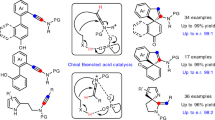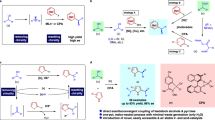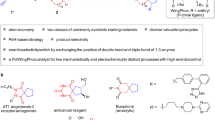Abstract
The formation of chiral organic molecules from Friedel–Crafts reactions of chiral alcohols has been deemed impractical due to racemization via carbocation formation. Here we demonstrate the preservation of stereochemistry in intramolecular Friedel–Crafts alkylation reactions, expanding the boundaries of accessible chiral chemistry. Mechanistic investigations show that the retention of stereochemistry stems from the chirality memory of transient, axially chiral carbocation intermediates. This finding allows the synthesis of axially chiral spirocarbon-bridged conjugated carbocycles. Leveraging a rhodium-catalysed regioselective C–H activation–annulation approach, the reaction of thiobenzamide with phenylethynyl tertiary alcohol is a crucial step in expanding the spiro-bridged skeleton. We used this approach to develop an iterative synthetic sequence to construct enantiopure spirocarbon-bridged pure-hydrocarbon oligo(trans-stilbene) compounds. Notably, in the concluding step of the iterative synthesis, all chiral tertiary alcohol units undergo a stereospecific one-shot conversion to form multiple spirocyclic structures, resembling a ‘zipping up’ process. This synthetic strategy facilitates both the longitudinal and lateral extension of spiro-bridged conjugated structures, with promising applications in circularly polarized lasers.

This is a preview of subscription content, access via your institution
Access options
Subscribe to this journal
Receive 12 digital issues and online access to articles
$119.00 per year
only $9.92 per issue
Buy this article
- Purchase on SpringerLink
- Instant access to full article PDF
Prices may be subject to local taxes which are calculated during checkout






Similar content being viewed by others
Data availability
The data that support the findings of this study are available within the Article and its Supplementary Information. Data are also available from the corresponding authors upon reasonable request. The X-ray crystallographic data for the structures reported in this Article have been deposited at the Cambridge Crystallographic Data Centre (CCDC) under deposition numbers 2291836 (5), 2289728 (9), 2294270 (11), 2294275 (rac-13), 2303144 ((R,R)-14 and (S,S)-14), 2294277 (rac-15), 2294278 ((R)-15), 2294279 ((R,S)-17 and (S,R)-17), 2294280 ((R,S)-19), 2294281 ((R,S,R)-21 and (S,R,S)-21), 2294282 ((R,S,R)-21), 2291829 (27), 2291826 (30) and 2294290 ((S,S)-34). These data can be obtained free of charge from the Cambridge Crystallographic Data Centre (CCDC) via www.ccdc.cam.ac.uk/data_request/cif. Source data are provided with this paper.
References
Saragi, T. P. I., Spehr, T., Siebert, A., Fuhrmann-Lieker, T. & Salbeck, J. Spiro compounds for organic optoelectronics. Chem. Rev. 107, 1011–1065 (2007).
Poriel, C. & Rault-Berthelot, J. Dihydroindenofluorenes as building units in organic semiconductors for organic electronics. Chem. Soc. Rev. 52, 6754–6805 (2023).
Urieta-Mora, J., Garcia-Benito, I., Molina-Ontoria, A. & Martín, N. Hole transporting materials for perovskite solar cells: a chemical approach. Chem. Soc. Rev. 47, 8541–8571 (2018).
Jiang, Y. et al. Organic solid-state lasers: a materials view and future development. Chem. Soc. Rev. 49, 5885–5944 (2020).
Samuel, I. D. W. & Turnbull, G. A. Organic semiconductor lasers. Chem. Rev. 107, 1272–1295 (2007).
Xie, J.-H. & Zhou, Q.-L. Chiral diphosphine and monodentate phosphorus ligands on a spiro scaffold for transition-metal-catalyzed asymmetric reactions. Acc. Chem. Res. 41, 581–593 (2008).
Oniki, J., Moriuchi, T., Kamochi, K., Tobisu, M. & Amaya, T. Linear [3]spirobifluorenylene: an S‑shaped molecular geometry of p‑oligophenyls. J. Am. Chem. Soc. 141, 18238–18245 (2019).
Hamada, H., Itabashi, Y., Shang, R. & Nakamura, E. Axially chiral spiro-conjugated carbon-bridged p-phenylenevinylene congeners: synthetic design and materials properties. J. Am. Chem. Soc. 142, 2059–2067 (2020).
Cheng, X., Zhang, Q., Xie, J.-H., Wang, L.-X. & Zhou, Q.-L. Highly rigid diphosphane ligands with a large dihedral angle based on a chiral spirobifluorene backbone. Angew. Chem. Int. Ed. 44, 1118–1121 (2005).
Wendlandt, A. E., Vangal, P. & Jacobsen, E. N. Quaternary stereocentres via an enantioconvergent catalytic SN1 reaction. Nature 556, 447–451 (2018).
Singh, V. K. et al. Taming secondary benzylic cations in catalytic asymmetric SN1 reactions. Science 382, 325–329 (2023).
Pronin, S. V., Reiher, C. A. & Shenvi, R. A. Stereoinversion of tertiary alcohols to tertiary-alkyl isonitriles and amines. Nature 501, 195–199 (2013).
Tan, X. et al. Enantioselective synthesis of tetraarylmethanes through meta-hydroxyl-directed benzylic substitution. Nat. Synth. 2, 275–285 (2023).
Zhao, C., Toste, F. D., Raymond, K. N. & Bergman, R. G. Nucleophilic substitution catalyzed by a supramolecular cavity proceeds with retention of absolute stereochemistry. J. Am. Chem. Soc. 136, 14409–14412 (2014).
Zhang, R., Ge, S. & Sun, J. SPHENOL, a new chiral framework for asymmetric synthesis. J. Am. Chem. Soc. 143, 12445–12449 (2021).
Li, S., Zhang, J.-W., Li, X.-L., Cheng, D.-J. & Tan, B. Phosphoric acid-catalyzed asymmetric synthesis of SPINOL derivatives. J. Am. Chem. Soc. 138, 16561–16566 (2016).
Cheng, X., Hou, G.-H., Xie, J.-H. & Zhou, Q.-L. Synthesis and optical resolution of 9,9′-spirobifluorene-1,1′-diol. Org. Lett. 6, 2381–2383 (2004).
Peluso, P. & Chankvetadze, B. Recognition in the domain of molecular chirality: from noncovalent interactions to separation of enantiomers. Chem. Rev. 122, 13235–13400 (2022).
Pirkle, W. H. & Pochapsky, T. C. Considerations of chiral recognition relevant to the liquid chromatographic separation of enantiomers. Chem. Rev. 89, 347–362 (1989).
Yang, Y. et al. Discovery of organic optoelectronic materials powered by oxidative Ar–H/Ar–H coupling. J. Am. Chem. Soc. 146, 1224–1243 (2024).
Liu, C.-X. et al. Rhodium-catalyzed asymmetric C–H functionalization reactions. Chem. Rev. 123, 10079–10134 (2023).
Dalton, T., Faber, T. & Glorius, F. C−H activation: toward sustainability and applications. ACS Cent. Sci. 7, 245–261 (2021).
Yang, Y., Lan, J. & You, J. Oxidative C–H/C–H coupling reactions between two (hetero)arenes. Chem. Rev. 117, 8787–8863 (2017).
Yin, J. et al. Programmable zigzag π-extension toward graphene-like molecules by the stacking of naphthalene blocks. Nat. Synth. 2, 838–847 (2023).
Lu, Q. et al. Redox-neutral manganese(I)-catalyzed C–H activation: traceless directing group enabled regioselective annulation. Angew. Chem. Int. Ed. 56, 12778–12782 (2017).
Yin, J. et al. Synthesis of phenalenyl-fused pyrylium cations: divergent C–H activation/annulation reaction sequence of naphthalene aldehydes with alkynes. Angew. Chem. Int. Ed. 56, 13094–13098 (2017).
Cheng, J. K., Xiang, S.-H., Li, S., Ye, L. & Tan, B. Recent advances in catalytic asymmetric construction of atropisomers. Chem. Rev. 121, 4805–4902 (2021).
Wu, S. et al. Urea group-directed organocatalytic asymmetric versatile dihalogenation of alkenes and alkynes. Nat. Catal. 4, 692–702 (2021).
Kawabata, T., Yahiro, K. & Fuji, K. Memory of chirality: enantioselective alkylation reactions at an asymmetric carbon adjacent to a carbonyl group. J. Am. Chem. Soc. 113, 9694–9696 (1991).
Takase, K., Noguchi, K. & Nakano, K. Circularly polarized luminescence from chiral spiro molecules: synthesis and optical properties of 10,10′-spirobi(indeno[1,2-b][1]benzothiophene) derivatives. Org. Lett. 19, 5082–5085 (2017).
Morales-Vidal, M. et al. Carbon-bridged oligo(p-phenylenevinylene)s for photostable and broadly tunable, solution-processable thin film organic lasers. Nat. Commun. 6, 8458 (2015).
Okada, D. et al. π‑Electronic co-crystal microcavities with selective vibronic-mode light amplification: toward Förster resonance energy transfer lasing. Nano Lett. 18, 4396–4402 (2018).
Jiang, Y. et al. Frequency-upconverted stimulated emission by up to six-photon excitation from highly extended spiro-fused ladder-type oligo(p-phenylene)s. Angew. Chem. Int. Ed. 60, 10007–10015 (2021).
Ren, S. et al. Circularly polarized lasing from helical superstructures of chiral organic molecules. Angew. Chem. Int. Ed. 63, e202415092 (2024).
Acknowledgements
We acknowledge financial support from the National NSF of China (22031007, 22371196, 22171130 and 22071162), the Natural Science Foundation of Sichuan, China (2022NSFSC0029), Guangdong Provincial Key Laboratory of Catalysis (2020B121201002), the New Cornerstone Science Foundation through the XPLORER PRIZE and Fundamental Research Funds for the Central Universities. Computational work was supported by the Center for Computational Science and Engineering and the CHEM High-Performance Supercomputer Cluster (CHEM-HPC) of the Department of Chemistry, Southern University of Science and Technology. We also thank P. Deng and D. Luo from the Analytical and Testing Center of Sichuan University for high-temperature NMR spectroscopy and crystal-structure analysis, respectively.
Author information
Authors and Affiliations
Contributions
X.P. performed the experiments and analysed the data. Y.L. performed the DFT calculations. Z.Z. performed the optically pumped lasing measurements under the guidance of Y.S.Z. J.Y. and J.L. designed and directed the project. P.Y. directed the DFT calculations and analysed the computational data. X.P., J.L., Y.Y., P.Y., C.Z. and J.Y. wrote the paper. All authors contributed to discussions.
Corresponding authors
Ethics declarations
Competing interests
The authors declare no competing interests.
Peer review
Peer review information
Nature Synthesis thanks Koki Ikemoto and the other, anonymous, reviewer(s) for their contribution to the peer review of this work. Primary Handling Editor: Peter Seavill, in collaboration with the Nature Synthesis team.
Additional information
Publisher’s note Springer Nature remains neutral with regard to jurisdictional claims in published maps and institutional affiliations.
Supplementary information
Supplementary Information
Supplementary Sections 1–16, Tables 1–72, Figs. 1–104 and experimental details.
Supplementary Data 1
Crystallographic data for compound 5, CCDC 2291836.
Supplementary Data 2
Structure factors for compound 5, CCDC 2291836.
Supplementary Data 3
Crystallographic data for compound 9, CCDC 2289728.
Supplementary Data 4
Structure factors for compound 9, CCDC 2289728.
Supplementary Data 5
Crystallographic data for compound 11, CCDC 2294270.
Supplementary Data 6
Structure factors for compound 11, CCDC 2294270.
Supplementary Data 7
Crystallographic data for compound 13, CCDC 2294275.
Supplementary Data 8
Structure factors for compound 13, CCDC 2294275.
Supplementary Data 9
Crystallographic data for compound 14, CCDC 2303144.
Supplementary Data 10
Structure factors for compound 14, CCDC 2303144.
Supplementary Data 11
Crystallographic data for compound (R)-15, CCDC 2294278.
Supplementary Data 12
Structure factors for compound (R)-15, CCDC 2294278.
Supplementary Data 13
Crystallographic data for compound rac-15, CCDC 2294277.
Supplementary Data 14
Structure factors for compound rac-15, CCDC 2294277.
Supplementary Data 15
Crystallographic data for compound 17, CCDC 2294279.
Supplementary Data 16
Structure factors for compound 17, CCDC 2294279.
Supplementary Data 17
Crystallographic data for compound 19, CCDC 2294280.
Supplementary Data 18
Structure factors for compound 19, CCDC 2294280.
Supplementary Data 19
Crystallographic data for compound rac-21, CCDC 2294281.
Supplementary Data 20
Structure factors for compound rac-21, CCDC 2294281.
Supplementary Data 21
Crystallographic data for compound (R,S,R)-21, CCDC 2294282.
Supplementary Data 22
Structure factors for compound (R,S,R)-21, CCDC 2294282.
Supplementary Data 23
Crystallographic data for compound 27, CCDC 2291829.
Supplementary Data 24
Structure factors for compound 27, CCDC 2291829.
Supplementary Data 25
Crystallographic data for compound 30, CCDC 2291826.
Supplementary Data 26
Structure factors for compound 30, CCDC 2291826.
Supplementary Data 27
Crystallographic data for compound 34, CCDC 2294290.
Supplementary Data 28
Structure factors for compound 34, CCDC 2294290.
Supplementary Data 29
Statistical source data for supplementary figures.
Source data
Source Data Fig. 6
Source data for Fig. 6c–e.
Rights and permissions
Springer Nature or its licensor (e.g. a society or other partner) holds exclusive rights to this article under a publishing agreement with the author(s) or other rightsholder(s); author self-archiving of the accepted manuscript version of this article is solely governed by the terms of such publishing agreement and applicable law.
About this article
Cite this article
Pu, X., Lu, Y., Zhou, Z. et al. Chirality retention in Friedel–Crafts spiroannulation for iterative synthesis of spiro-bridged conjugated carbocycles. Nat. Synth (2025). https://doi.org/10.1038/s44160-025-00817-4
Received:
Accepted:
Published:
DOI: https://doi.org/10.1038/s44160-025-00817-4



